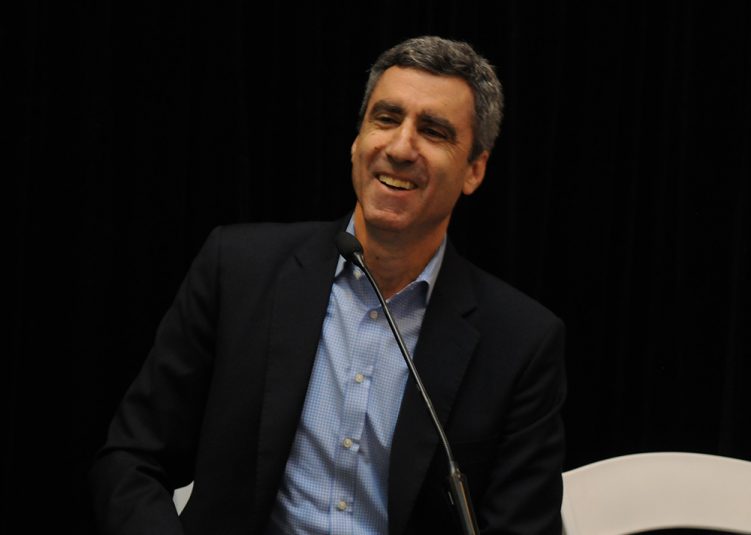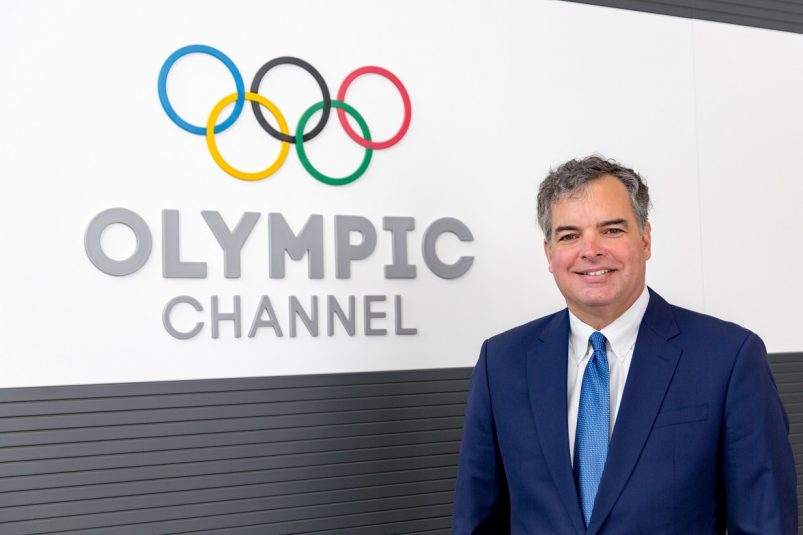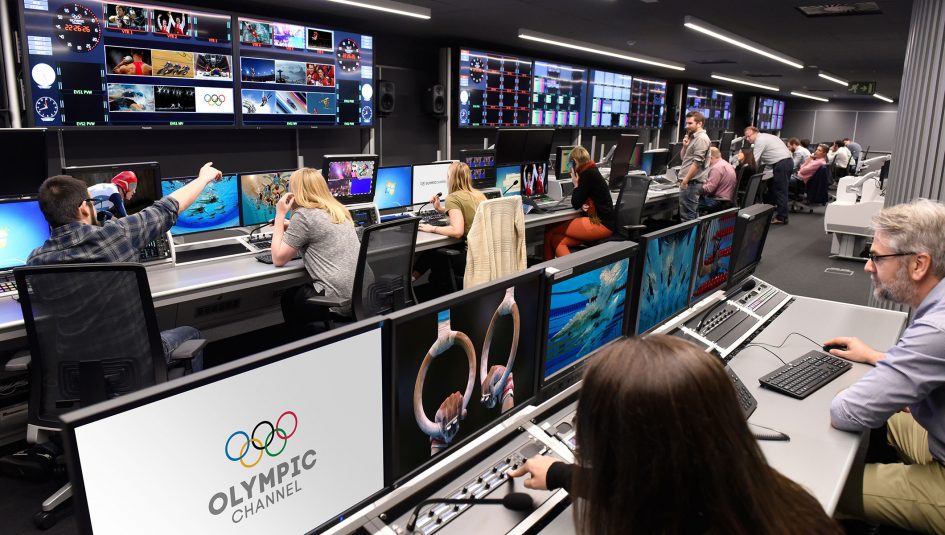NBC’s Olympic Channel Ready To Go for Gold
Carriage in 35 million homes is only the beginning
Story Highlights
Tomorrow at 6 a.m. ET, the Olympic Channel will become the latest sports network to hit the nation’s cable and satellite boxes. The new channel — the result of a partnership between NBCUniversal, the International Olympic Committee (IOC), and the U.S. Olympic Committee (USOC) — promises to give Olympic sports a more consistent presence among sports fans who typically tune in only every two years.
“To put it simply, the Olympic Games will now have a home between the Games being played,” says Mike Tirico, primetime host, NBC Olympics. “Those sports and those athletes will have a home where we can not only appreciate their talents but watch the best in the world continue to compete. The next generation come along.”

NBC Sports Group’s Gary Zenkel: “These platforms form a powerful content-distribution system. This is an exciting day for us.”
According to Gary Zenkel, president, NBC Olympics and Business, NBC Sports Group, the network will launch in more than 35 million homes.
“These platforms form a really powerful content-distribution system where we will bring, again, the great content of the three parties together and make it accessible to this broad U.S. audience as we lead into and lead out of each of the next seven-plus Olympic Games,” says Zenkel. “This is an exciting day for us.”
The programming strategy will be wide-ranging with an emphasis on live Summer and Winter Olympic Sports events and will also feature Olympic-themed original content produced by all three parties. Content will comprise original programs commissioned by the global Olympic Channel and produced by filmmakers from around the world, rich archival footage from the IOC and NBCU libraries of Olympic features and documentaries, and original Team USA programming produced by the USOC.
The opening weekend will be highlighted by coverage of the IAAF Diamond League this Sunday from Rabat, Morocco.
The IOC launched the Olympic Channel on the day of the Closing Ceremony of the 2016 Summer Olympics in Rio. Its technical operations are based at the OBS technical facility in Madrid, where control rooms and editing suites are used to produce a wealth of content from sports federations around the globe. The goal for the original channel is to give sports that may not have TV coverage a greater visibility around the globe and more relevance in the digital age.
But the launch of the Olympic Channel in the U.S. signals an important step forward for the service and its role in giving U.S. athletes greater visibility.

The Olympic Channel’s Mark Parkman: “This is the first step, and it speaks volumes of the commitment that NBC and the USOC have in the Olympic movement.”
“When we launched the global digital Olympic Channel at the close of the Rio Games, we said that it was going to be an evolutionary product,” says Mark Parkman, GM of the IOC’s global Olympic Channel. “And Saturday is one of the major milestones of our evolution, when we come with a linear-channel launch in the USA in partnership with our wonderful partners, the NBC and Team USA, USOC organizations. This is the first step, which we think will continue to grow the Olympic Channel, its brand throughout the world, and it speaks volumes of the commitment that NBC and the USOC have in the Olympic movement.”
The Technical Side of Things
Much of the content will be produced by the Olympic Channel and NBCUniversal will leverage technical and production assets in Stamford, CT; Denver; and Englewood Cliffs, NJ, bringing content in from the Olympic Channel and preparing it for U.S. distribution. Tim Canary, VP, engineering, NBC Sports Group and NBC Olympics, says that the technical and production efforts have been coming together during the past six months and one of the anticipated changes will be a large increase in the amount of content that will originate in Denver.
“We were able to leverage our connectivity between Denver and Englewood Cliffs and use Evertz MPEG-4 encoders to get that content back and forth, We added two outbound lines from Denver and two return lines so they can see the master control return back in Denver,” he explains. “We can also get those outbound lines and see them in Stamford. If Denver wants to send us some content, we can see what they’re doing as well, which is very helpful.”
The ramp-up in Denver did not require much in the way of additional equipment with only a couple of updated ChyronHego Mosaic systems and an additional EVS XT3 server required. One key enhancement is that personnel in Denver can access Stamford’s asset-management system and transfer content using Aspera or FileCatalyst.
“It a lot of file movement of content for both live and archival content,” adds Canary.
Additional work in Denver included adding three AWS Elemental streaming encoders to complement three Ateme encoders. NBCUniversal also changed the network configuration to allow the encoders to transit existing connectivity to iStream Planet and have content sent over to the Olympic Channel in Madrid.
“This arrangement gives us more flexibility with our digital offering for the channel,” says Canary.
He adds that the team in Denver, largely the former Universal Sports team, is phenomenal at doing events and those skills have been an asset. Live event coverage will rely on everything from world feeds that can be voiced-over in the U.S. (primarily in Denver) to more-important events, where trucks or flypacks could be used to add unilateral enhancements to a world feed.
“There are some events coming up this month where we will deploy the NEWBERT remote-controlled flypack that is then connected to Control Room 8, our mostly IP-based control room,” says Canary. “Denver can also share to load with two-ways and other things. It’s certainly been busy but it’s going quite smoothly on the technology side.”
Philosophically, the launch of the Olympic Channel is an extension of an effort that sees the Stamford digital center as a hub for program creation on the NBC Network, NBC Sports Network, USA Network, and even MSNBC.
“The beauty of our facility in Englewood Cliffs is, if you have a commercial, it’s going to air across multiple channels,” says Canary. “They ingest the commercial once and can play it wherever. Having that arrow in our quiver has been a big help.”
A Difference Maker for USOC
When the IOC launched the Olympic Channel, one of the goals was not only to give the Olympic brand more-consistent exposure between Games but to also to create the next generation of Olympic athlete and fan.
“One of the missions that we created in the global Olympic Channel was to get more youth involved in sport through inspiring them through the storytelling we are doing,” says Parkman. “So, yes, we are hopeful that, through what we are doing both on the global scale and the local scale and through our digital platforms, we are going to inspire a new generation to become more participatory in sport, to become more participatory in Olympic sport, and to build that next generation of Olympic fans.”
To USOC CMO Lisa Baird, the partnership is important because it gives the USOC a level of production that was previously unattainable.
“There is only so much we can do at a production to be able to focus on the stories of hundreds of Team USA athletes and to bring coverage of competition of Olympic and Paralympic sport,” she says. “One thing this does is, it exponentially increases not only the coverage that you heard about but the ability to produce and bring great content, competition, and storytelling immediately. I think that’s the biggest benefit.”
USA Track and Field CEO Max Siegel says that, with robust offerings set to include documentaries and archival footage, the Olympic Channel will help bring the personalities and stories to the public each year of the Olympic cycle. “Together with USATF’s annual event coverage on NBC and its networks, the Olympic Channel is a critical part of providing 360-degree programming for track and field and all Olympic Sports.”
And, for an organization like USA Archery, the exposure could help create the next generation of competitive archers.
“With increased exposure for often untelevised sports, people will be better able to see the full scope of the Olympics and share the incredible stories of all of Team USA athletes,” says Denise Parker, CEO, USA Archery.
Zenkel believes that the growth of the channel will depend on audience engagement, and, with carriage in 35 million homes, he expects growth on the virtual-MVPD side.
“They have almost all embraced the channel from the get-go, so there’s probably some growth there,” he says. “It’s important to note that the Olympic Channel partnership involves the linear channel and hundreds of hours of programming, linear programming, on NBC and NBCSN.
“It is a very robust distribution system as those channels are obviously fully distributed,” he continues. “So the audience in the United States is going to have many opportunities to access this content. My hunch is, there will be an interest in seeing that which might not be accessible to those who are not being distributed the channel.”
Additional reporting by Jason Dachman, Chief Editor

